What Does the Lesbian Flag Look Like? Here's Why You Might See So Many Variations of the Lesbian Flag

When we think of the Pride flag, the rainbow-striped flag of course comes to mind. It appears a ton during Pride Month or can be seen hanging outside of queer people and allies’s homes. It’s an emblem of joy and celebration for the LGBTQ+ community and is just as bright as it is symbolic. But in addition to that flag, which represents the whole community, most LGBTQ+ groups have their own flags, including lesbians. And while the Pride flag has gone through a few iterations, the lesbian flag has a whole history of its own too.
The lesbian flag has a handful of varying styles, with all of them still in use today by various parts of the community. Unlike the rainbow Pride flag—or the Progressive Pride flag with the more inclusive triangle of colors on the left side—there isn’t one set lesbian flag that is universally accepted. However, based on its history and certain meanings conflated with different lesbian flags, there is one that is more widely accepted and hung up more often.
With Lesbian Visibility Week coming up—April 24-28, 2024—read on to learn what the many lesbian flags look like, what the colors mean and which lesbian flag is “right.”
What is the lesbian flag?
There are five popular lesbian flags that you might see out in the wild or during a Pride parade. But one that you will usually see the most often is the Orange-Pink Lesbian flag, or the 5-color lesbian flag. This lesbian flag has five vertical stripes, starting with a reddish-orange on top, followed by a paler orange, with white in the middle, and a dark pinky purple after, with the bottom color being a darker magenta.
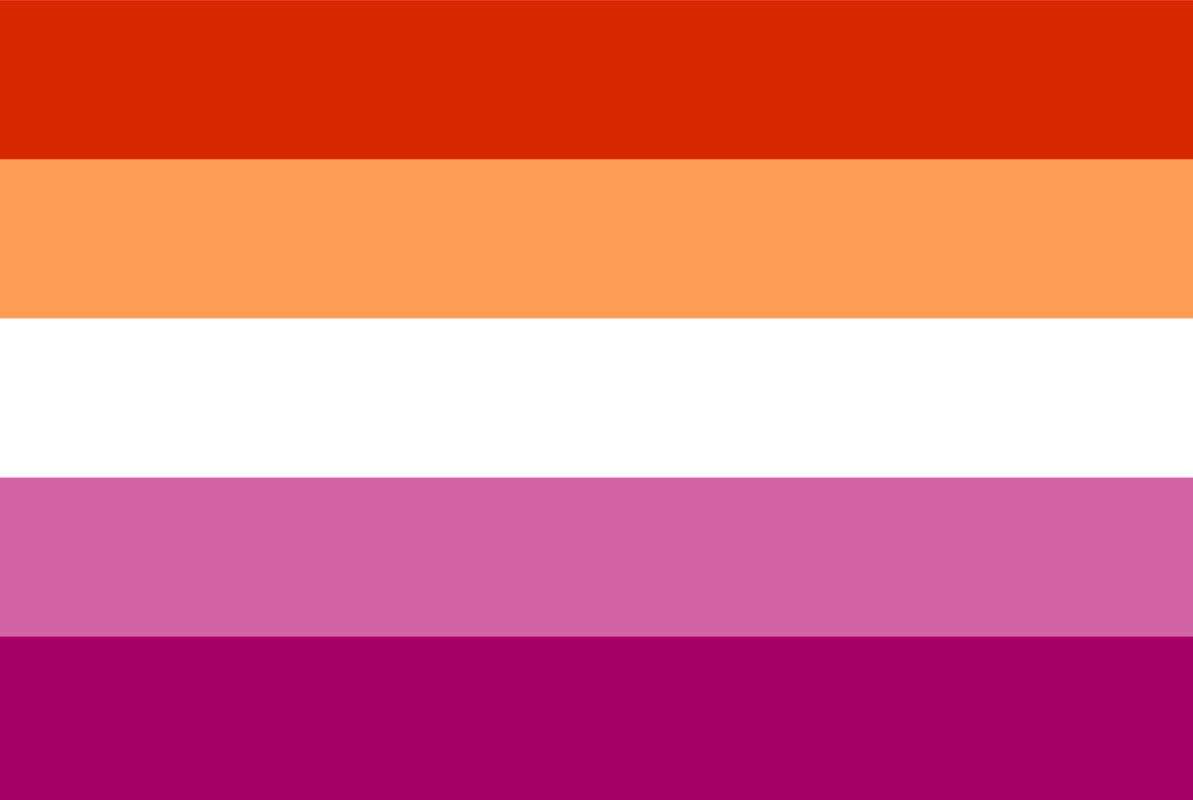
iStock
We’ll go into the history in a bit, but this five-color flag is a simplified version of the “Sunset” Lesbian flag that came out in 2018. That flag has seven stripes, all signifying a different yet integral part of the lesbian community and identity.
Related: What Does 'Sapphic' Mean? Here’s What the Word Means and How It Relates to ‘WLW’
What does the lesbian flag look like?
If you were to ask, “What are the colors of the lesbian flag?” there isn’t one answer, as you’ve probably guessed. While the simplified Orange-Pink Lesbian flag is, well, mostly orange and pink, the very first lesbian flag was actually mostly a deep purple color.
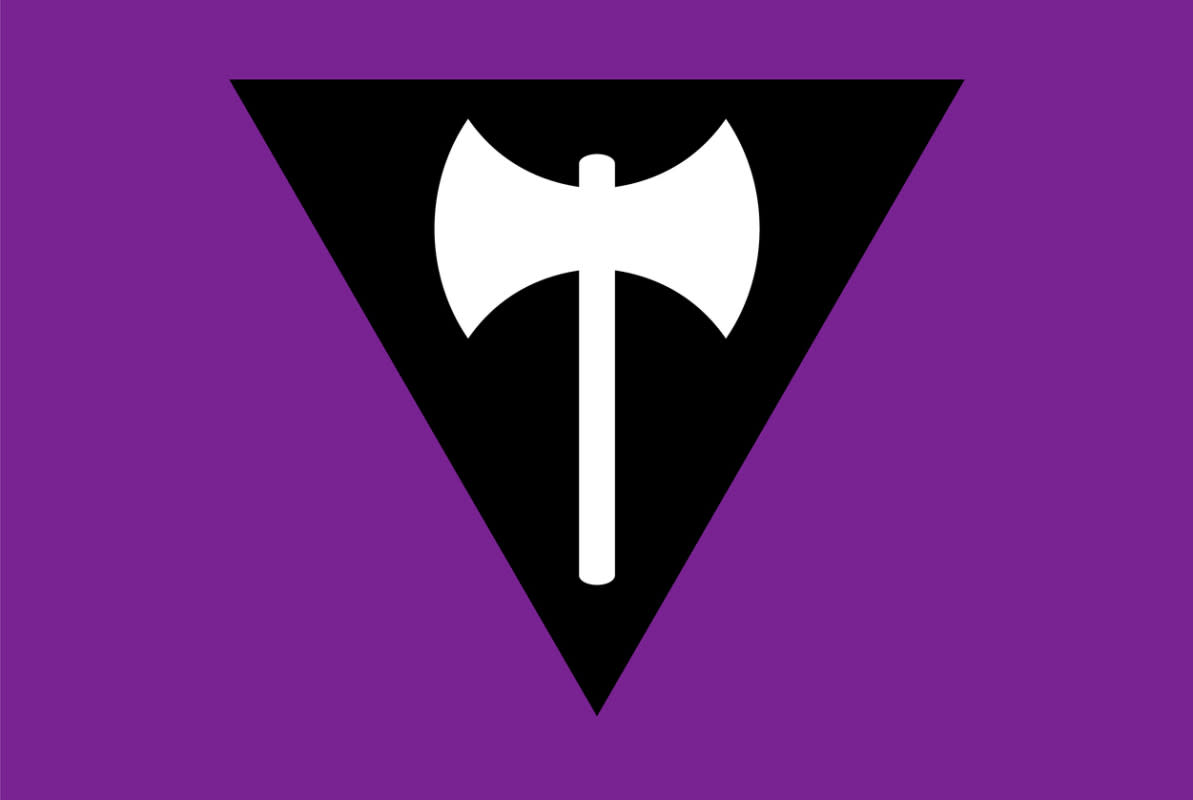
iStock
Graphic designer Sean Campbell designed the first lesbian flag in 1999, known as the Labrys Lesbian flag. It made its debut to the world in 2000 in Palm Springs's version of the Gay and Lesbian Times Pride issue. The background of the flag is a deep purple and there’s an upside-down triangle in the middle. In the middle of that triangle is a white labrys, which was an ancient Greek weapon that consisted of a double-headed battle axe.
The labrys itself was adopted by feminist lesbians back in the 1970s as a symbol of empowerment. As for the triangle, a pink upside-down triangle has long been a gay emblem taken from the symbol for homosexual men in concentration camps during the Holocaust. During this time, homosexual women were among the group labeled with an upside-down black triangle; this symbol was given to “asocial” or “work-shy” prisoners. So, Roma and Sinti people, alcoholics, lesbians, homeless people and others were labeled with this symbol.
And the purple background has long been a color associated with lesbians, from lavender (Lavender Menace) to violets and more, purple is a big color for this community (and is what the purple stripe on the rainbow Pride flag represents).
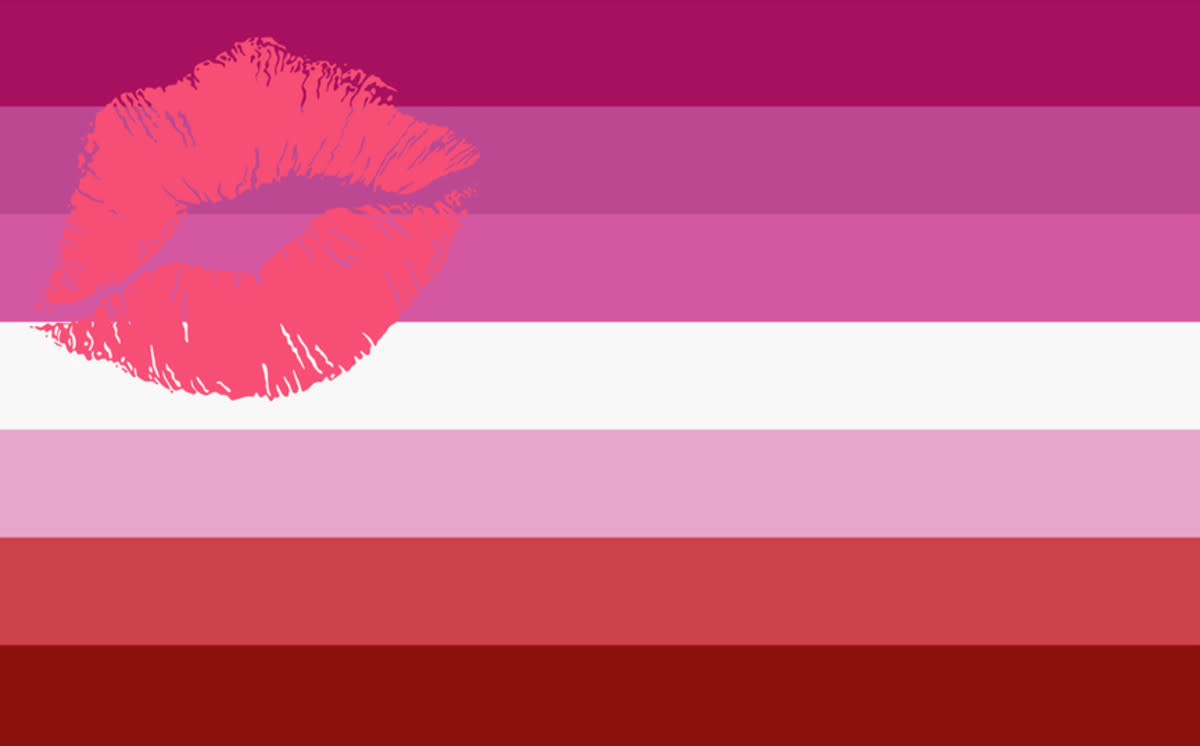
iStock
While the Labrys Lesbian flag took a lot of symbols important to the lesbian community and put them to good use, it was still created by a gay, cis man. So, it makes sense that the next flag was created by an actual lesbian. Natalie McCray designed the Lipstick Lesbian flag in 2010, when it was posted on the website This Lesbian Life. It was meant to represent more femme-presenting lesbians—a term that means lesbians that are more feminine—with the term “lipstick lesbian” meaning that as well.
This flag has seven stripes in various shades of pink, ranging from darker magenta on top, pink-purple, pink, white, pale pink, coral and finishing out with burgundy. It then had a lipstick print in the top left corner. However, the term “lipstick lesbian” has always been a bit controversial, since it dates back to this concept of lipstick-wearing women having sex with each other in 1980s porn for male enjoyment.
While the term was reclaimed by lesbians in the 90s and early aughts to push back against the notion that all lesbians are butch or more masculine, the flag still carries a ton of controversy since McCray’s blog had racist, biphobic and transphobic rhetoric in it, tainting what the Lipstick Lesbian flag means because of where it came from.
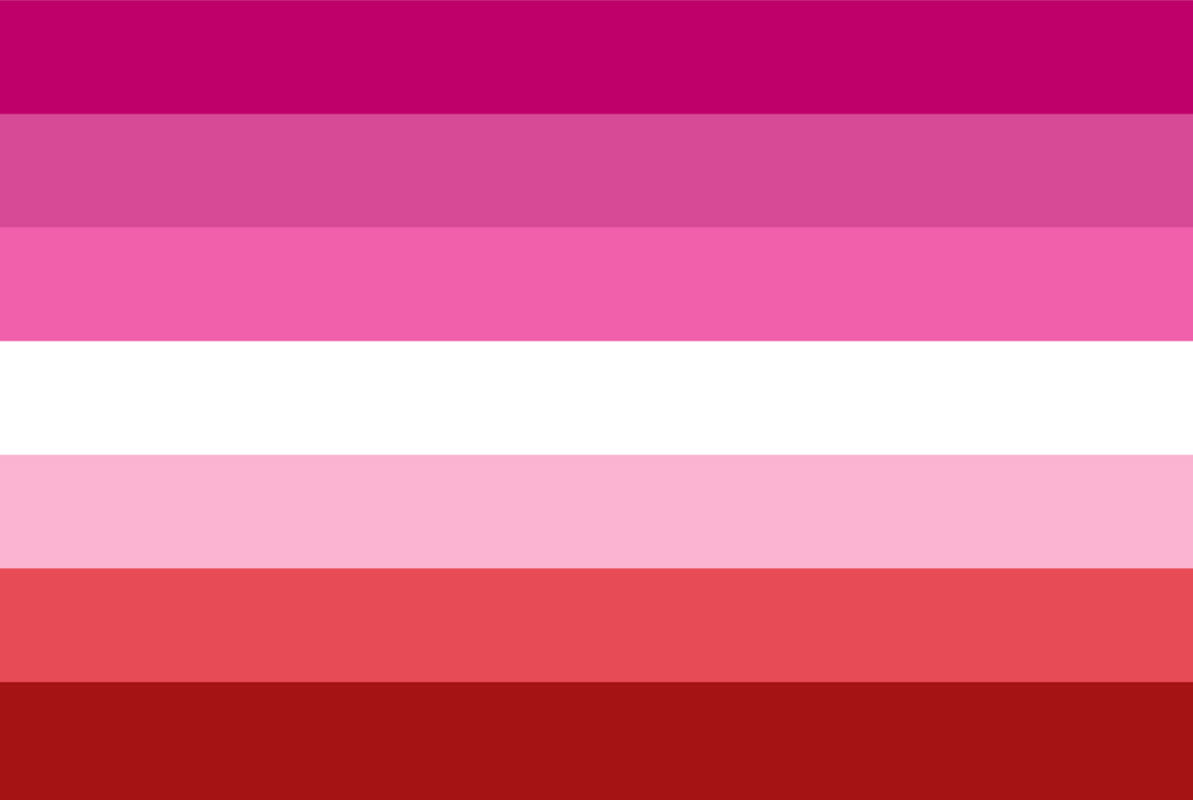
iStock
To make the lesbian flag more inclusive—since the Lipstick Lesbian flag, in its essence, excluded masculine lesbians and any lesbian who didn’t identify or dress as femme—the lipstick print in the top left corner was removed and the Pink Lesbian flag was born. This flag was the most common and widely used for a long time, and still is seen often. But because it was created by someone who was problematic and excluded key members of the LGBTQ+ community—People of Color, bisexuals and trans people—this Pink Lesbian flag still has a sour history and some have moved on from it because of that.
You might also see two other flags that belong to the lesbian community and they both have to do with butch lesbians. There’s the 2016 Butch lesbian flag that has various shades of blue vertical stripes, and there’s a 2017 version that is mostly made up of oranges and browns, with each stripe representing a different attribute of butch lesbians. These weren’t widely adopted, but hold a special place for butch and masc lesbians.
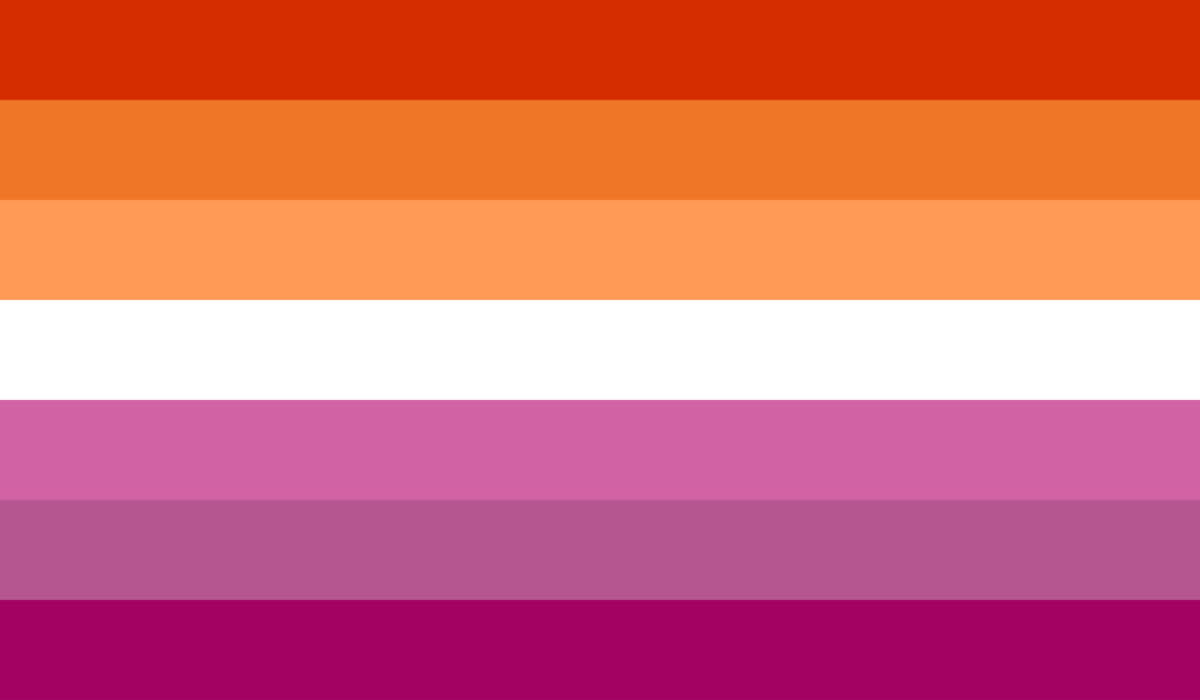
iStock
That brings us to the most recent iteration of the lesbian flag: the Orange-Pink Lesbian flag or the more colloquially termed Sunset Lesbian flag. The Sunset Lesbian flag was made in 2018 by Emily Gwen, a non-binary lesbian Tumblr blogger. This flag takes the seven stripes from the Lipstick Lesbian flag, changes the colors to more oranges and pinks and gives them each a meaning that has to do with the lesbian community.
Related: Best Pride Memes
What do the colors of the lesbian flag mean?
As stated above, the Sunset Lesbian flag’s seven different stripes represent different aspects of the lesbian community. The top color is the same reddish-orange we mentioned before from the 5-color Orange-Pink Lesbian flag. This symbolizes “gender non-conformity.” The next is a lighter orange, which represents “independence.” Then there’s pale orange, which stands for “community.” The white in the middle of the flag represents “unique relationships to womanhood.” The next stripe is a dark pinkish purple which stands for “serenity and peace” and it’s followed by a darker purple-pink, which is for “love and sex.” The final stripe is a deep magenta which stands for “femininity.”
As of today it's been 2 years since I first designed the orange and pink lesbian flag. Thank you so much for all the love I've been shown since then. The lesbian communities I'm a part of mean so much to me. pic.twitter.com/nn8oNW3uDc
— Emily Gwen (@theemilygwen) June 3, 2020
Since its debut in 2018, Gwen’s Lesbian flag has quickly become widely accepted and because of the meaningful attributes of the colors and Gwen’s overall respect for the lesbian community at large—which they are also a part of—while creating it. Their flag is the most progressive and inclusive, therefore making the 7-striped and simplified 5-color Sunset Lesbian flags one of the most common lesbian flags you’ll see today.
Related: 40 LGBTQIA+ TV Shows You Really Should Binge-Watch to Celebrate Pride Month
Which lesbian flag is right?
Again, there isn’t an official lesbian flag; all of these flags are still used by various members of the lesbian community today. Unfortunately, different flags have been appropriated by unaccepting members of the community, though. Both the Labrys Lesbian flag and the Lipstick Lesbian flags have had loud TERF (trans-exclusionary radical feminist) lesbians claim them. While the Labrys Lesbian flag doesn’t have origins in transphobia, that’s unfortunately what some associate it with now. And because of McCray’s own transphobia (along with her other hateful speech), the Lipstick Lesbian flag is very much associated and accepted by some TERF lesbians.
Neither flag, though, is a direct TERF dog whistle; it’s not fair to deem everyone that waves them as transphobic or hateful. However, the most recent Sunset Lesbian flag is the most progressive, accepting and least problematic flag lesbians have at their disposal. So if you want something inclusive and positive, that might be the best option for you.
Next up, get ready for June with 40 Pride Month Gifts to support the LGBTQ+ community.
